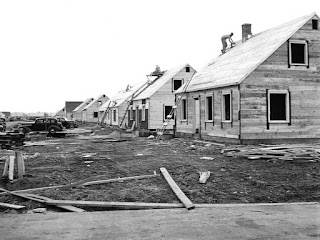 |
Taliesin, Frank Lloyd Wright's home at
Spring Green, Wisconsin: Not on the hill, but of the hill.
Image: Taliesin Preservation Inc. |
“The physician can bury his mistakes,” Frank Lloyd Wright told the New York Times in 1953, “but the architect can only advise his client to plant vines.”
Such wisecracking aside, Wright probably new better than most architects the value of integrating nature into his work, and not just as a remedy for aesthetic failure.
A visit to Taliesin, the home he began building in central Wisconsin in 1911, makes this amply clear: The house is wrapped around the crest of a hill on three sides--”not on the hill, but of the hill”, as Wright liked to say--and the erstwhile farmboy’s love for nature informs every nook and cranny of the place. Wright continued working on Taliesin right up to his death in 1959.
 |
Like all great examples of modernist architecture,
Taliesin is truly inseparable from its site. |
Whether cottage or mansion, a truly livable house should, like Taliesin, seem inseperable from its site. Sometimes, the simple passage of time and the attendant growth of planting are enough to create this effect, as many an overgrown bungalow will testify. If you can’t wait around fifty years, however, there are also a number of design strategies that can help weave a new home or addition into its site right from the start.
 |
Broad steps and terraces seamlessly join the house
to the outdoors despite challenging changes in elevation. |
• Build decks or terraces as close as possible to the interior floor level, rather than having a back-porch-like stair leading down to them. Since a house that’s markedly above the outside ground level can feel cut off from the outdoors, creating outdoor space that’s flush with the ground floor will both visually expand the interior space and help integrate it with the surroundings.
 |
Wright was a master at extending landscape elements
out from the house itself, expanding its feeling of space
and blurring the lines between indoors and out. |
If the vertical distance to the outside grade is more than a couple of feet, consider having several levels of decks or terraces that gradually step down to the ground. Use level changes of two or at most three steps, each no more than six inches high, and avoid using single steps, as they can create a tripping hazard. Integrate planters or beds for trees and shrubs into the layout to help visually smooth the transition from indoors to out.
• Except where there are doors leading outside, don’t install paving or other ground-level hardscaping right up to your home’s exterior walls. A house with bare paving meeting bare walls has about as much connection to its setting as the hotel on a Monopoly board. A better approach is to leave a planting bed at least three feet wide between the foundation and any paving. Make sure you provide drainage so this area doesn’t become a swamp during the rainy season.
 |
Taliesin surround a garden courtyard that forms a series of
outdoor rooms—a design strategy common in Asia,
but far too seldom seen in the West. |
• Extend architectural details such as walls, colonnades, or porches from the house into the surrounding landscape. One of Wright’s favorite techniques was to have low walls radiating root-like from the building, visually tying it to its site. Often, these walls also formed integral planters that helped from a transition to the natural landscape.
Traditional architects could be equally adept at this technique: Spanish Revival homes, for example, often featured an arcade or a pergola extending from the house into the garden, or a covered veranda that formed a space halfway between indoors and out.
• Lastly, always think of your house as an integral part of its site, rather than being an object placed on top of it. Plan the garden as a series of outdoor rooms that are an extension of the indoor ones, and make the ones nearest the house serve as transition points between inside and out.





















